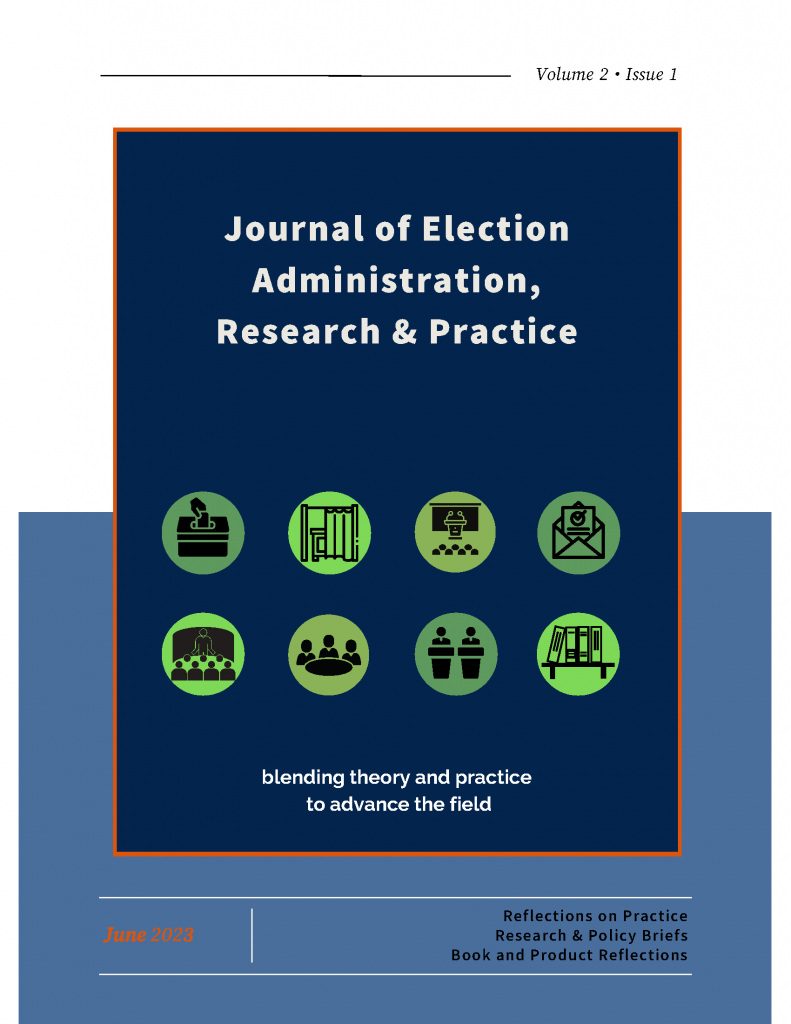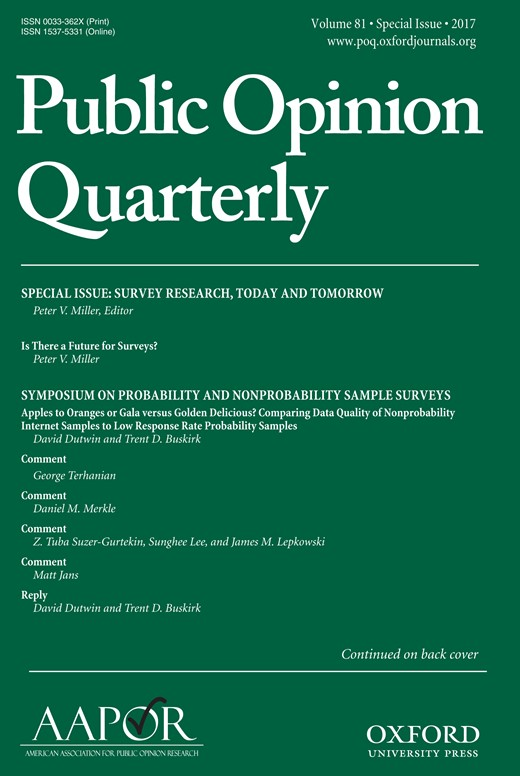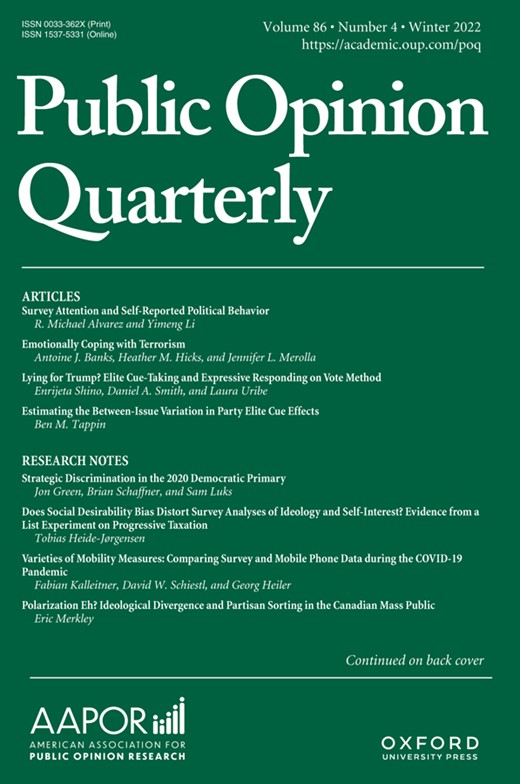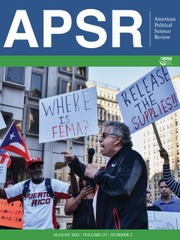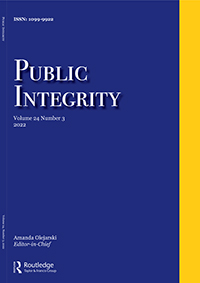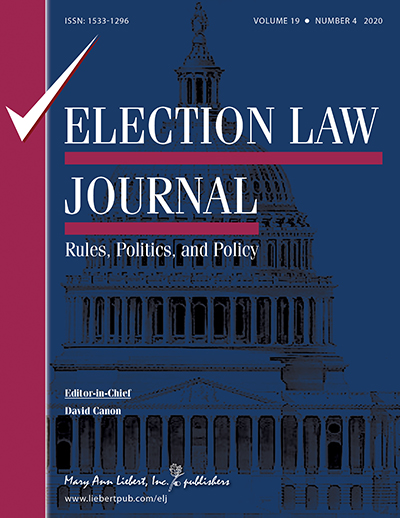Research
Publications

United States Precinct Boundaries and Statewide Partisan Election Results
We describe the creation and verification of databases of all precinct boundaries used in the United States 2016, 2018, and 2020 November general elections, enhanced with election results for all partisan statewide offices. United States election officials report election results in the smallest geographic reporting known as the precinct. Scholars and practitioners find these election results valuable for numerous use cases. However, these data cannot be augmented with other geographically-bound data, such as U.S. Census data, without precinct boundaries.
Campus Voting During the COVID-19 Pandemic
How did the pandemic impact turnout of young voters living in university communities? Leveraging the mandatory vacating of Florida college students living on campuses and drawing on administrative data from Florida’s voter file, we argue that on-campus registered young voters who had to leave their university housing in the days prior to Florida’s 2020 Presidential Preference Primary (PPP) were less likely to turn out compared to adjacent off-campus young voters because they lost the opportunity to cast early in-person and Election Day ballots.

The fall of Trump: Mobilization and vote switching in the 2020 presidential election
Did voters use salient issues to inform their vote choice in the 2020 presidential election? UF Election Lab professor Daniel Smith, former UF PhD grad Enrijeta Shino (now at the University of Alabama), and Seth McKee (Oklahoma State University) leverage a classic voter typology advanced by V.O. Key and draw on Cooperative Election Study (CES) data to analyze the effects of short-, medium-, and long-term issues informed turnout and the vote for president in the 2020 election. They find that new voters in 2020 and voters switching their preferences from 2016 cast their ballots in favor of Democrat Joe Biden. In the end, President Donald Trump was denied reelection by new voters and vote switchers principally because certain issues had a notable effect in moving their presidential preferences in the Democratic direction.
Mail Voting and Voter Turnout
Does the expansion of voting by mail lead to higher turnout rates? UF Election Lab professors Michael McDonald and Daniel Smith, along with former UF PhD grad Enrijeta Shino (now at the University of Alabama) and current PhD student Julianna Mucci, challenge the theoretical motivation underlying existing studies that find merely no change, or worse a decrease in turnout, in states that have more expansive mail balloting. Their primary innovation is to measure mail ballot usage instead of simple dichotomous measures of the presence of a particular law, such as whether or not a state runs vote-by-mail elections or has no-excuse absentee voting. They find states with greater usage of mail voting experience higher overall voter turnout.
From Pandemic to Insurrection: Voting in the 2020 US Presidential Election
In this book about the historic 2020 US presidential election, UF Election Lab professor Michael McDonald provides a history of mail balloting in the United States and describes how election officials manage mail balloting. He documents the extensive legal battles over the expansion of mail balloting in the midst of the global pandemic, starting in the primary elections through the general election. He ends with an assessment of what happened afterwards, and recommendations on how to improve trust and performance of future elections.
Riot in the Party? Voter Registrations in the Aftermath of the January 6, 2021 Capitol Insurrection
UF Election Lab professor Daniel Smith and UF undergraduate alum Sara Loving examine people who changed their Florida party registration following the 6 January 2021 insurrection. They find registered voters who switched parties were more likely to be white, middle-aged, high-propensity voters, and that Republicans were nearly four times more likely than Democrats to defect following the insurrection. We also find that the GOP defection rate after January 6th was nine times higher than during the same time period in 2017. However, we find that Republican registrants who switched parties post-riot did not migrate to the Democratic Party, but rather became independents, and that a year later, almost no Republicans (only 4.6%) who had defected returned to their GOP roots..
Verifying Voter Registration Records
In an innovative survey design UF Election Lab professors McDonald and Smith, along with UF PhD graduate Enrijeta Shino and UF professor Michael Martinez, ask people to verify the information on their voter registration records, knowing in advance the information found in the voter file. We ask follow-up questions when respondents’ answers are at odds with the records. We suggest voter registration forms should be treated like survey questionnaires so as to improve data quality with better form design, and that some vote over-report bias is attributable to limitations of voter file data, not to respondents’ vote misreporting.
The Effects of Election Administration Changes on Voters of Color in Florida
Drawing on an original representative survey of over 3,000 registered Florida voters, UF Election Lab professor Daniel Smith, along with UF PhD alumna Enrijeta Shino and UF PhD student LaRaven Temoney, examine the likely effects of Senate Bill 90 (SB90), signed into law in 2021 by Governor Ron DeSantis. They find that Black and Hispanic voters were more likely to report registering with a 3PVRO, Black voters were less likely to say they registered to vote with an ID that is required to request a VBM ballot, and Black voters were more likely to report having used a VBM drop box in the 2020 General Election. They conclude that voters of color are likely more heavily burdened by the implementation of SB90.
When Boundaries Collide: Constructing a Database of Election and Census Data
A difficulty when analyzing election results is that precinct boundaries do not always align nicely with other administrative boundaries, such as the Census Bureau’s geography used to report population statistics. In this Public Opinion Quarterly article UF Political Science PhD graduate Brian Amos and UF professor Michael McDonald review techniques to resolve this problem and develop the most robust methodology to create accurate statistics in this situation, using a technique known as dasymetric mapping. We use this technique when the UF Election Lab disseminates precinct boundary data enhanced with census data.
A Method to Audit the Assignment of Registered Voters to Districts and Precincts
Recently, elections in Georgia and Virginia were brought into question because some voters were given the wrong ballot – a number greater than the margin of victory. UF Political Science PhD graduate Brian Amos and UF professor Michael McDonald call this phenomenon administrative redistricting and develop a methodology to detect when it happens. They identify thousands of registered voters assigned to the wrong district and worked with election officials across the country to proactively fix these problems, including services the UF Election Lab provided to the Colorado Secretary of State and Virginia Division of Elections.
Lying for Trump? Elite Cue-Taking and Expressive Responding on Vote Method
UF Election Lab professor Daniel Smith, Phd graduate Enrijeta Shino, and undergraduate alum Laura Uribe analyze a survey of Florida registered voters. They find retrospective and prospective misreporting of vote method (if a person voted by mail) prior to the 2020 General Election was driven primarily by support for Trump. The president’s supporters who were most politically aware were most likely to disavow their own voting by mail and misreport their anticipated vote method in the November election. Understanding the effects—and limits—of elite cues on the politicization of self-reported political behavior has important implications for pollsters and campaigns, election administrators, voters, and the broader democratic electoral process.
Weather to Vote: How Natural Disasters Shape Turnout Decisions
UF Election Lab professor and undergraduate alum William Zelin examine the effects of Hurricane Michael on voting in Florida in the 2018 General Election. They find that turnout was lower among those directly impacted by the storm but that early in-person voting helped to mitigate the effects. These findings lend insight into how election administration decisions can offset the deleterious effects of a catastrophic event.
The Racial Politics of Early In-Person Voting in Georgia
UF Election Lab professor Daniel Smith and Michael Herron (Dartmouth College) examine the effects of changes in 2021 in Georgia to voting rules – in particular, available days of early in-person voting. They show that other things, Black voters in Georgia are more likely than White voters to cast ballots on the early voting days scrutinized during legislative debates over a new voting law, even though there is no evidence that offering early voting on any particular day has any substantive implications for election integrity. The recent battle in Georgia over ballot access and early voting in particular illustrates the continued grip of racial politics in the United States, even concerning technical debates over election rules and procedures.
The Myth of the Vanishing Voter
In a seminal early 2000’s article published in the American Political Science Review, the top political science journal, UF professor Michael McDonald coined the phrase “voting-eligible population” (VEP) as a contrast to the voting-age population (VAP), which at the time was used widely to calculate turnout rates. Prof. McDonald showed ineligible populations – such as noncitizens and ineligible felons, depending on state law – were increasing, thereby giving a false impression United States’ turnout rates were declining. This simple recalculation of turnout rates invalidated an entire sub-field of American politics research which sought to understand why turnout rates were declining. Prof. McDonald continues to update VEP turnout rates here, which are used in the national media’s election night coverage and by Minnesota’s Secretary of State as their official turnout rate.
Election Administration and Public Records Responsiveness
UF Election Lab professor Daniel Smith, PhD graduate Enrijeta Shino, and undergraduate alumni Anna Baringer, Justin Eichermuller, and William Zelin conduct a field experiment that solicits public records to we test how county election offices respond to requests under given conditions. They find the response rates of Florida’s 67 Supervisors of Elections (SOE) to a request for election administration data and election protocols after the 2018 General Election varies considerably, but that the formality of the language and the email domain randomly assigned only marginally affects the compliance of election officials to abide by the state’s public records statutes. The variance in responses and lack of compliance seems to not be related to who asks for data nor how it is solicited, but rather is idiosyncratic. Despite the largely null findings, the study raises concerns about local election administration and transparency.
Mobilizing the Youth Vote? Early Voting on College Campuses
UF Election Lab professor Daniel Smith and PhD graduate Enrijeta Shino explore if the targeted adoption of early in-person voting on the campuses of public colleges and universities lowers the barriers of casting a ballot, increasing the turnout of young registrants. They estimate the effect of the expansion of early in-person voting on eight public campuses and find uneven effects of the policy reform on overall turnout. They find evidence the adoption of on-campus early voting not only made it more likely that young registrants exposed to the policy turned out to vote, but that it also shifted the timing of when these young voters cast a ballot.
Reprecincting and Voting Behavior
UF Election Lab professor Daniel Smith, PhD graduate Brian Amos, and undergraduate Alum Casey Ste Claire explore if those registered voters who are reassigned to a different Election Day polling place prior to an election are less likely to turn out to vote than those assigned to vote at the same precinct location. Their case study is Manatee County, Florida, during the 2014 General Election. They show the redrawing of precinct boundaries and the designation of Election Day polling places may affect voter turnout of some registered voters more than others. Most notably, they find that registered Hispanic voters were significantly more likely to abstain from voting as a result of being reassigned than any other racial group.
A Failsafe for Voters? Cast and Rejected Provisional Ballots in North Carolina
UF Election Lab professor Daniel Smith and PhD graduate Thessalia Merivaki examine who is more likely to cast a provisional ballot, and more importantly, why some provisional ballots are rejected. They suggest that beyond individual-level factors, there are administrative reasons why some prospective voters are more likely to be required to cast provisional ballots than others, and why some provisional ballots are rejected.

Timing the Habit: Voter Registration and Turnout in the American States
UF Election Lab professor Daniel Smith and PhD graduate Enrijeta Shino Does explore if registering in near proximity to a presidential election are more likely to vote in the upcoming election compared to those who register at other times during an election cycle. They find that the timing of registration does affect turnout, as last-minute registrants are not equally likely to vote in ensuing elections.
Events
The UF Election Lab has hosted the following election science events and conferences:
2020 Election Science Reform and Administration Conference
Student Research
2020 University of Florida Undergraduate Research Symposium
Check out our awesome undergraduates fellows present their research via YouTube videos at the 2020 University of Florida Undergraduate Research Symposium!
Anna Baringer. “Did Generation Z, Millennials and Generation X outvote older generations in 2018 General Election?” https://bit.ly/3bPECqn
William Zelin. “Weathering the Storm: Did Hurricane Michael Affect Voter Behavior in Florida in the 2018 General Election?” https://bit.ly/2wNwAQk(opens in new tab)
Emily Boykin and Jenna Tingum. “The Turnout Effects of Spanish-Language Voting Materials in Florida.” https://bit.ly/3dYVux4(opens in new tab)
2020 Southern Political Science Association Student Papers
The Florida Election Sciences group went on the road to San Juan, Puerto Rico to present our research at the 2020 Southern Political Science Association Conference. We had a rocking good time (literally) presenting undergraduate research projects:
Anna Baringer (University Scholars Program, Honors, Graduated 2020) and Prof. McDonald, The Age Turnout Gap and State Context in the 2018 Election
Emily Boykin (University Scholars Program, Honors, Graduated 2020), Jenna Tingum (University Scholars Program, Honors, Graduating 2020), and Prof. Smith, The Turnout Effects of Spanish-Language Voting Materials in Florida
Thomas J. Eichermuller (Honors, Graduated) and William Zelin (CLAS Scholars Program, Honors, Graduated 2020), Statewide Standards for Florida Elections
Laura Uribe (Graduated 2019), Co-Ethnic Clustering and Voting Behavior in Broward County, Florida
William Zelin (CLAS Scholars Program, Honors, Graduated 2020) and Prof. Smith, Weathering the Storm: Did Hurricane Michael Affect Voter Behavior in Florida in the 2018 General Election?
Election Data Sciences Class Projects
Prof. Michael McDonald teaches a combined graduate and undergraduate class on election data science where students learn to analyze election data using the R programming language. Students post their final projects online, some of which they have presented at professional conferences. Follow the links to see the students’ Fall 2009 projects:
- Emily Boykin <Link> This project seeks to explore the similarities and differences of state election systems, and offer descriptive and visual analysis of the data at hand. Utilizing the confidential voter files of U.S. states, I analyze the different ways in which race, gender, birth identification, voter status, and party identification variables are classified by a sample of states. I utilize and read in .yaml files to code five different data frames on these variables, in which I map via a shapefile of the United States on a subjective key I created.
- Steven Calcutt <Link> This is a study on how people convicted of a felony are registered to vote in the state of North Carolina. This study goes into their gender, race, age, and which party they were registered with. To control I used the general population of North Carolina in the voter file. I decided to do my project on this because of the impact that Amendment 4 could have on the electorate in Florida. It is important for anyone running a campaign to understand this data and apply it as necessary to their campaign strategy.
- Sydney ElDeiry <Link> In this paper, I examine the effect that the shooting of Michael Brown by police officer Darren Wilson and the succeeding demonstrations had on voter registration in Ferguson and throughout St. Louis County, determining that communities can engage in politics through various avenues.
- Delaney Goman <Link> A Georgia registration policy active in the 2018 midterm election was strikingly similar to a discriminatory policy struck down in 2016. An examination and analysis of the profile of applicants who failed the state’s restrictive exact-match policy and their turnout.
- John Latimer <Link> My project explores the relationship between partisan identification and political trust. By utilizing organizational scholarship, I explain how partisan sorting might very well be the result of falling trust in the federal government. Though unable to show causation, the initial results are hopeful.
- Peter Licari <Link> In this project, I use precinct-level data from the state of Florida — in addition to a small, custom dataset of active greyhound race tracks — to examine how precinct proximity to a greyhound track affects precinct-level support for an amendment which banned dog racing and precinct-level turnout on that issue. I found that proximity increases support for the amendment but depresses turnout.
- Sara Loving <Link> The goal of this project is to determine how the number of voters who register with a political party affiliation varies over an election cycle.
- Madison Smith <Link> This project analyzes turnout data in Florida, 2016. Specifically, I am analyzing the effects of female candidates on turnout down the ballot.
- Jenna Tingum <Link> This project evaluates Vote-By-Mail rejection rates and rejection likelihood at the county and state level in Florida. The primary objective is to study time predictors that lead to rejection, but the larger goal is to visualize and understand the Florida voter whose Vote-By-Mail ballot is rejected.
- Madeleine Wagner <Link> I examine the strength of partisan transfer among Cuban American households in Miami-Dade and comparing it to the rest of the county. I study the basic level of homogeneity of Cuban households, as well as the level of full/partial/no transfer households and finally transfer by party.
- Joel Zemach <Link> This analysis aims to demonstrate the effects of implementing Automatic Voter Registration (AVR) legislation on overall registration volume. I will use the Oregon state voter file to exemplify the effects of AVR on voter registration rates and will narrow my analysis to include data from 2015-2019 to capture the effects of this legislation. Automatic Voter Registration took effect in Oregon on January 1, 2016.






